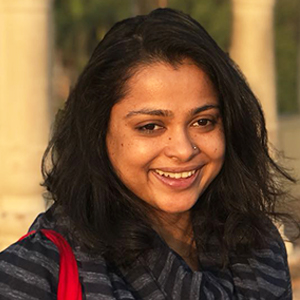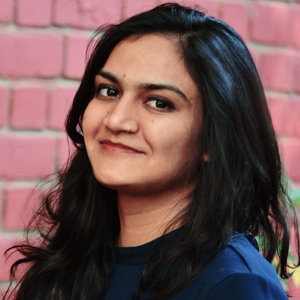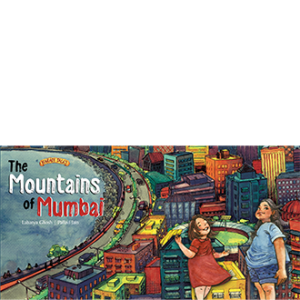The Mountains of Mumbai has garnered international praise and acclaim, and was recently the winner of the Neev Book Award, 2020, in the Picture Book category. We catch up with the author, Labanya Ghosh, and the illustrator, Pallavi Jain, to get their reactions to the win, and know more about the process behind getting the book ready.


1. First, congratulations to you both on winning the Neev Book Award! As a first-time author and illustrator, how does it feel to have your debut book win an award?
Labanya: I know it’s a buzzword/contemporary mantra but – GRATEFUL. At this point – in this global pandemic, I am clutching on to sunbeams whenever they may appear.
Pallavi: Thank you very much! It feels really great that our first book is winning over so many hearts. It’s truly encouraging to see all the work we did under the guidance of Karadi Tales, and time we spent on getting the minutest of details right, bear fruit and so soon! This was a very happy surprise in 2020.
2. The Mountains of Mumbai has received high praise from reviewers all around the world, why do you think this book resonates with so many readers?
L: I think ‘friendship’ is a universal language. The ability of humans to continually spark connection to bring about a sense of belonging not only in themselves but also for others in their lives- it happens all the time, either consciously or subconsciously. I think it resonates with everyone.
P: I think the book works on multiple levels. It celebrates childhood wonder, curiosity and also the spirit of childhood friendships. This book also shows us a way to celebrate diversity without exoticising it. It easily resonates with people who have travelled to or lived in Mumbai, and has the power to make them nostalgic. There are a lot of evocative references in the book, some specific to this city and others that are reminiscent of a time rather than a place, which makes it relatable to a larger group of readers.
3. Labanya, what inspired you to write this story? Where did the idea come from?
L: The story eventually took a different turn and it’s come to stand for many things now, but at the start, I wanted to re-imagine a city that’s got a particularly notorious reputation when it comes to tourism or as a place of residence/work. I wanted to show Mumbai the way I see it – the beauty in its chaos and its ever-resourceful and accommodating people. The inspiration came to me while walking around in Leh and in such a place of bare beauty, the contrast is so sharp, that the idea just presented itself.
4. Pallavi, when you received the manuscript, what made you want to illustrate it?
P: I think what I loved about the story most was that it was a fascinating journey of two little girls, through the streets of Mumbai, on their way to discover magic that usually eludes most of us adults. It was exciting for me to recreate the city I was born and brought up in, through the eyes of Veda and Doma.
5. Labanya, when you finally saw Pallavi’s illustrations, what did you think of them? And what do you like most about them?
L: Breathtaking. I could not have seen Mumbai the way she has. What I like the most is the visualization in terms of the city plan, and the ariel perspective done in bright water colours. It is the way I see my city – vibrant, and ideally from a tall building!
6. Could you tell us a little bit about what the process behind getting this book ready was like? Both in terms of text and illustration.
L: I think my process was fairly simple: quite a few rounds of edits, and then tweaking it ever so slightly once the illustrations came in. I wanted the language to be very simple in the hope that very young readers may also try reading it. I do recall our intense search to find a suitable name!
P: It was an amazing experience to go through the whole journey of creating the book. For me, the first step was to visualise the manuscript in a storyboard. We had a lot of intense discussions and back and forths about the tiniest of details. After several rounds of refinement and exchanging ideas, I got around to painting the actual pictures. These were hand-done illustrations that took unexpectedly long for me to finish, but that was the best part! I absolutely enjoyed painting the spreads and getting lost in the story. I think the creative liberty that I was given in the process had a lot to do in bringing out the essence of Mumbai.
7. Labanya, is this how you had imagined the book to look when you wrote it?
L: Not at all. I had a rather linear depiction in mind. And that’s why this creative process of working in silos and independently helps. Each is open to interpret – this ensures freedom of thought. There is, of course, the publisher who is able to mediate, bridge, and bring out the best possible combinations.
8. Was the editing process from your submission to the final edit to your satisfaction?
L: Yes, absolutely. And extremely smooth.
9. Pallavi, were you apprehensive when the publisher changed the size of the book after all the illustrations were complete?
P: I certainly had some concerns about the new size, since I had carefully composed the illustrations to be spreads that were bound in the middle. But I had faith in the team at Karadi Tales, and there was no doubt that the new layout was actually doing justice to the artwork. The first time I held the book, I knew there was no better way to have done it!
10. Was illustrating a picture book very different from other art that you have done?
P: Yes, it was a little daunting to make 14-16 spreads of intricate, handmade artwork in watercolor that is consistent throughout. Also, I felt very responsible about the kind of imagery, colours, and content that I was creating for the young readers. I loved the part where I discussed the details of the book with Shobha who was so passionate about it and took so much care about everything that went into it. It was a truly enriching and fulfilling experience.
11. Is there anything in particular you wish readers of your book would take away?
L: Can we see things differently from what we have always seen them to be?
As we make our way through this global pandemic – how can we see things differently to find ourselves some joy and spread some around too?
P: For the young readers, I would love for them to never lose their curiosity and imagination, and cherish their friendships.
For the adults who come across this, I hope it gives them a break from the ugliness of the world around them and a peek into a delightful place from their past! And if they’re open to it, they could learn a lot from Veda and Doma’s fearless journey to discover magic where we feel there is none left.






